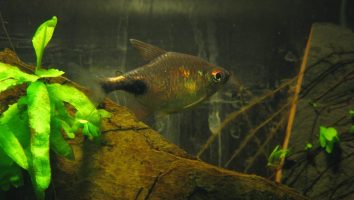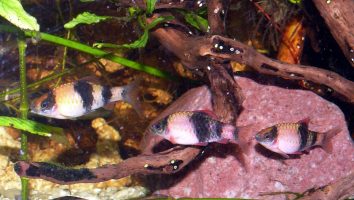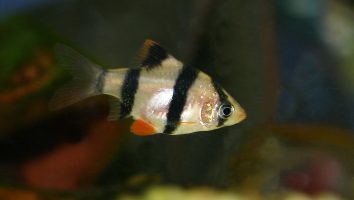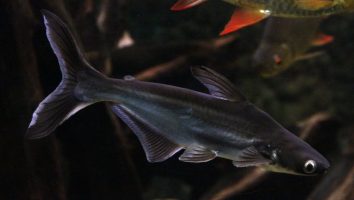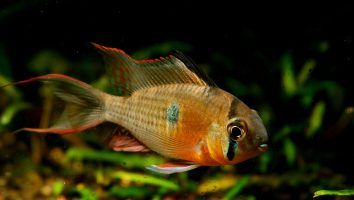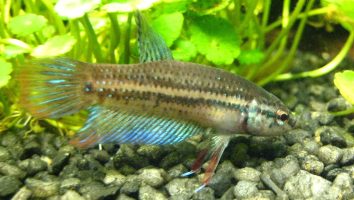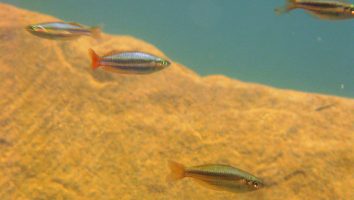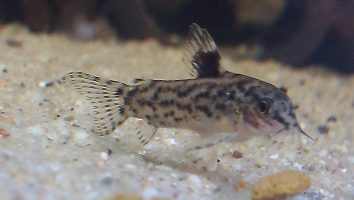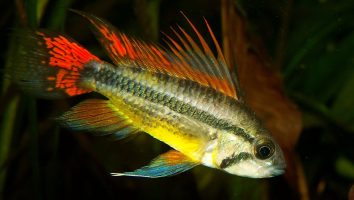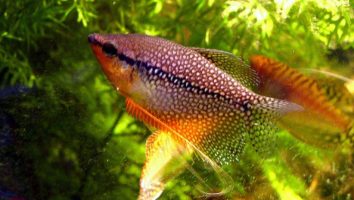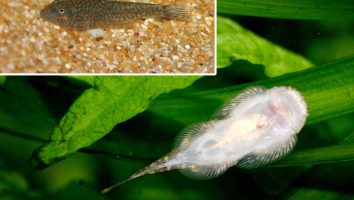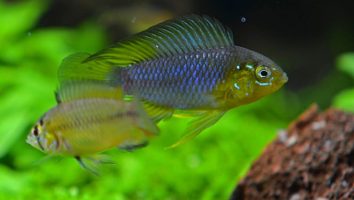The herring cichlid is a beautiful freshwater fish that is relatively easy to care for. They are a peaceful fish that make a great addition to any community tank.
This Fish Academia guide will teach you everything you need to know about herring cichlid care. You’ll learn about their diet, size, lifespan, and more!
Table of contents
Species overview
The herring cichlid (Nandopsis haitiensis) is a freshwater fish that is native to the island of Hispaniola.
This cichlid is found in both the Haiti and the Dominican Republic, and it is the only member of its genus.
The herring cichlid is a peaceful fish that prefers to live in groups. In the wild, these fish are found in slow-moving rivers and streams.
The herring cichlid is a popular choice for aquariums because it is a hardy fish that can adapt to a wide range of water conditions.
Appearance
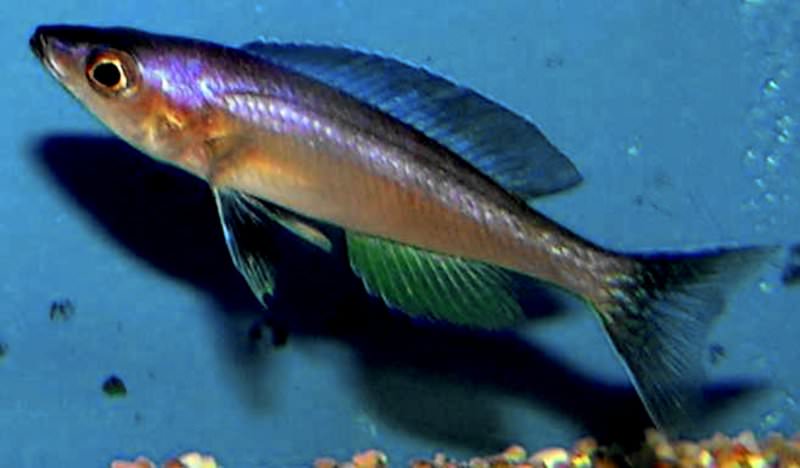
The Herring cichlid is a very pretty fish that has a unique coloration. The base color of the fish is a beautiful blue. This is then accented by a series of black stripes that run vertically down the body.
The fins on the Herring cichlid are also blue and have a black stripe running through the center. The dorsal and anal fins are long and extend back quite a bit. The caudal fin is forked and also has the black stripe running through it.
The Herring cichlid has a long and thin body that is slightly compressed. This gives them a unique shape that helps them move quickly through the water.
The Herring cichlid is a very peaceful fish that is a good addition to any community tank. They are not aggressive and will do well with other fish that are similar in size and temperament.
Lifespan
The average lifespan of a herring cichlid is around 5 years. This number can, of course, be affected by a number of different factors.
If the herring cichlid is kept in a well-maintained aquarium with good water quality then they will likely live on the higher end of this range.
Conversely, if they’re kept in poor conditions then their lifespan will be shortened significantly.
Size
The Herring cichlid can grow to be around 12 inches long, making it one of the larger species of cichlids. Females are typically smaller than males and will also have a more rounded belly.
Tank
Tank Size
The recommended tank size for Herring cichlids is at least 50 gallons. If you want to keep more than one fish, we recommend adding at least 20 gallons for each additional fish.
Herring cichlids are relatively peaceful fish but they are known to be jumpers. Make sure your tank has a tight fitting lid to prevent any accidental escapees.
Water Parameters
Like all cichlids, the herring cichlid is a fish that is very particular about its water parameters. These fish come from Africa and prefer to live in water that is on the alkaline side.
The ideal water parameters for a herring cichlid are as follows:
- Water temperature: 75 to 82 degrees Fahrenheit
- pH levels: 7.5 to 8.5
- Water hardness: 10 to 20 dGH
- Alkalinity Levels: 10 to 30 dKH
What To Put In Their Tank
The first thing you need to do when setting up a tank for Herring cichlids is to pick the right size.
These fish grow to be pretty big (up to 18 inches in some cases) and they’re very active. That means you need an aquarium that can accommodate their size and provide them with plenty of room to swim.
The next thing you need to do is choose the right substrate. These fish love to dig and sift through the substrate looking for food. A sandy substrate is going to be the best choice in this case.
Something else you need to consider is the plants you’re going to put in their tank. Herring cichlids are known to uproot plants, so you need to choose something that can withstand that.
We recommend going with hardier plants like Hornwort or Java Fern. These are both great options that can handle a little abuse.
As for other decorations, it’s really up to you. These fish don’t have any specific needs, so you can get creative. Just make sure you don’t overdo it since these fish need plenty of room to swim.
Common Diseases
There are a few diseases that you need to be aware of when keeping Herring cichlids. While these fish are relatively hardy, they can still succumb to poor water conditions or the presence of parasites and pathogens.
The most common disease that affects this species is ich. This is a very contagious disease that can be fatal if left untreated. The most obvious sign of ich is the presence of white spots on the body, fins, and gills of your fish.
If you notice this, it’s important to act fast. Begin treatment immediately and consult your vet if necessary.
Other potential diseases include hole-in-the-head disease, fungal infections, and bacterial infections. These are all rather common in the freshwater world and can affect any fish if the conditions are right.
Once again, the best way to prevent these diseases is by maintaining a clean and stable tank. Herring cichlids are hardy fish but they still need high-quality water to thrive.
Behavior & Temperament
The Herring cichlid is a beautiful, peaceful fish that is perfect for community tanks. They are relatively shy fish that spend most of their time hiding in the plants.
They are not an aggressive fish, but they can be territorial. They will generally leave other fish alone, but if two Herring cichlids meet, they may fight for dominance.
Herring cichlids are omnivores, so they will eat just about anything. They are known to eat algae, but they will also eat small insects and crustaceans.
Herring cichlids are very easy to care for and make a great addition to any community tank.
Tank Mates
When it comes to finding tank mates for a Herring cichlid, there are a few things to consider.
First, these fish are semi-aggressive. They can get along with other fish, but they might also pick on them from time to time.
Secondly, Herring cichlids come from brackish waters. As a result, they might not do well in a freshwater tank.
Third, these fish get large. They can reach up to 18 inches in length, so you’ll need a big tank to accommodate them.
Fourth, Herring cichlids are jumpers. They might not be able to jump out of your tank, but they can jump high enough to hit the glass and injure themselves.
With all of that in mind, here are some potential tank mates for a Herring cichlid:
- Silver Dollar Fish
- Bala Shark
- Green Terror Cichlid
- Rainbow Shark
- Clown Loach
- Fire Eel
- Convict Cichlid
Breeding
Herring cichlids are one of the easier fish to breed in captivity. They’re not too picky about their environment and will readily spawn in the home aquarium.
The first step is to set up a breeding tank. It should hold at least 20 gallons of water and have a sandy substrate. You can also add some rocks and plants to the tank, but make sure there are plenty of open spaces for the fish to swim.
The next step is to sex your fish. Females are typically larger than males and have a rounder body shape. Males also have longer fins.
Once you’ve determined the sexes of your fish, it’s time to add them to the breeding tank. Start with two females for every male.
The breeding tank should have a water temperature of around 78 degrees Fahrenheit. The pH should be between 6.5 and 7.5.
Once the fish are in the tank, they should start breeding on their own. The female will lay her eggs on a flat surface, like a rock or piece of driftwood. The male will then fertilize the eggs.
After the eggs have been fertilized, the male will guard them until they hatch. This usually takes about two weeks.
Once the fry have hatched, you can remove the adults from the tank. The fry will feed on microscopic organisms in the water. You can supplement their diet with baby brine shrimp or other live foods.
Conclusion
The Herring cichlid is a great fish for a beginner aquarist. They are very easy to take care of and are very peaceful.
The only thing that you need to be aware of is that they can grow to be quite large, so make sure you have a tank that is big enough for them.
Other than that, we think they make a great addition to any community tank and are sure you will enjoy them as much as we do!

